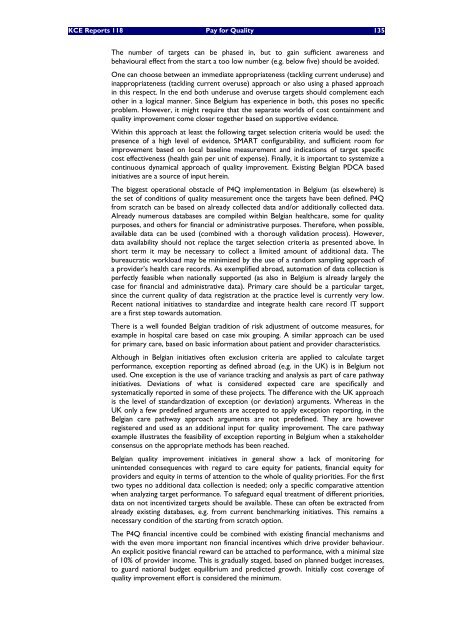Pay for Quality
Pay for Quality
Pay for Quality
You also want an ePaper? Increase the reach of your titles
YUMPU automatically turns print PDFs into web optimized ePapers that Google loves.
KCE Reports 118 <strong>Pay</strong> <strong>for</strong> <strong>Quality</strong> 135<br />
The number of targets can be phased in, but to gain sufficient awareness and<br />
behavioural effect from the start a too low number (e.g. below five) should be avoided.<br />
One can choose between an immediate appropriateness (tackling current underuse) and<br />
inappropriateness (tackling current overuse) approach or also using a phased approach<br />
in this respect. In the end both underuse and overuse targets should complement each<br />
other in a logical manner. Since Belgium has experience in both, this poses no specific<br />
problem. However, it might require that the separate worlds of cost containment and<br />
quality improvement come closer together based on supportive evidence.<br />
Within this approach at least the following target selection criteria would be used: the<br />
presence of a high level of evidence, SMART configurability, and sufficient room <strong>for</strong><br />
improvement based on local baseline measurement and indications of target specific<br />
cost effectiveness (health gain per unit of expense). Finally, it is important to systemize a<br />
continuous dynamical approach of quality improvement. Existing Belgian PDCA based<br />
initiatives are a source of input herein.<br />
The biggest operational obstacle of P4Q implementation in Belgium (as elsewhere) is<br />
the set of conditions of quality measurement once the targets have been defined. P4Q<br />
from scratch can be based on already collected data and/or additionally collected data.<br />
Already numerous databases are compiled within Belgian healthcare, some <strong>for</strong> quality<br />
purposes, and others <strong>for</strong> financial or administrative purposes. There<strong>for</strong>e, when possible,<br />
available data can be used (combined with a thorough validation process). However,<br />
data availability should not replace the target selection criteria as presented above. In<br />
short term it may be necessary to collect a limited amount of additional data. The<br />
bureaucratic workload may be minimized by the use of a random sampling approach of<br />
a provider’s health care records. As exemplified abroad, automation of data collection is<br />
perfectly feasible when nationally supported (as also in Belgium is already largely the<br />
case <strong>for</strong> financial and administrative data). Primary care should be a particular target,<br />
since the current quality of data registration at the practice level is currently very low.<br />
Recent national initiatives to standardize and integrate health care record IT support<br />
are a first step towards automation.<br />
There is a well founded Belgian tradition of risk adjustment of outcome measures, <strong>for</strong><br />
example in hospital care based on case mix grouping. A similar approach can be used<br />
<strong>for</strong> primary care, based on basic in<strong>for</strong>mation about patient and provider characteristics.<br />
Although in Belgian initiatives often exclusion criteria are applied to calculate target<br />
per<strong>for</strong>mance, exception reporting as defined abroad (e.g. in the UK) is in Belgium not<br />
used. One exception is the use of variance tracking and analysis as part of care pathway<br />
initiatives. Deviations of what is considered expected care are specifically and<br />
systematically reported in some of these projects. The difference with the UK approach<br />
is the level of standardization of exception (or deviation) arguments. Whereas in the<br />
UK only a few predefined arguments are accepted to apply exception reporting, in the<br />
Belgian care pathway approach arguments are not predefined. They are however<br />
registered and used as an additional input <strong>for</strong> quality improvement. The care pathway<br />
example illustrates the feasibility of exception reporting in Belgium when a stakeholder<br />
consensus on the appropriate methods has been reached.<br />
Belgian quality improvement initiatives in general show a lack of monitoring <strong>for</strong><br />
unintended consequences with regard to care equity <strong>for</strong> patients, financial equity <strong>for</strong><br />
providers and equity in terms of attention to the whole of quality priorities. For the first<br />
two types no additional data collection is needed; only a specific comparative attention<br />
when analyzing target per<strong>for</strong>mance. To safeguard equal treatment of different priorities,<br />
data on not incentivized targets should be available. These can often be extracted from<br />
already existing databases, e.g. from current benchmarking initiatives. This remains a<br />
necessary condition of the starting from scratch option.<br />
The P4Q financial incentive could be combined with existing financial mechanisms and<br />
with the even more important non financial incentives which drive provider behaviour.<br />
An explicit positive financial reward can be attached to per<strong>for</strong>mance, with a minimal size<br />
of 10% of provider income. This is gradually staged, based on planned budget increases,<br />
to guard national budget equilibrium and predicted growth. Initially cost coverage of<br />
quality improvement ef<strong>for</strong>t is considered the minimum.
















